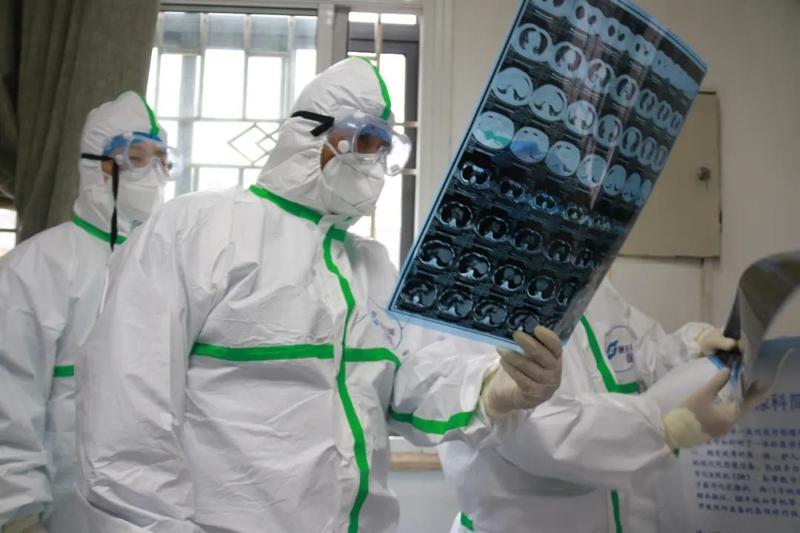 Tong Xiaolin (front), head researcher at the China Academy of Chinese Medical Sciences, checks a patient's test results at Wuhan Jinyintan Hospital in Hubei province on Jan 26. (PHOTO / XINHUA)
Tong Xiaolin (front), head researcher at the China Academy of Chinese Medical Sciences, checks a patient's test results at Wuhan Jinyintan Hospital in Hubei province on Jan 26. (PHOTO / XINHUA)
A ceremony was held to celebrate the contribution by role models in the country's fight against COVID-19 at the Great Hall of the People in Beijing on Sept 8.
Through taking traditional Chinese medicines, patients with symptoms of short of breath and asthma saw notable improvements
A 35-member traditional Chinese medicine team from the China Academy of Chinese Medical Sciences did an excellent job in fighting the outbreak.
During their 66-day work in Wuhan, capital of Hubei province, the hardest-hit Chinese city, they treated more than 100 severe COVID-19 patients, according to a report by Xinhua News Agency.
TCM has played an important role in prevention and control of the pandemic as well as the treatment and cure-it was involved early, participated entirely and complemented Western medicine with mutual collaboration.
ALSO READ: TCM can aid in agriculture development
When Huang Luqi, president of the China Academy of Chinese Medical Sciences, recalled the trip to Wuhan seven months ago. He was still emotional.
"Traditional Chinese medicine must intervene as soon as possible! I'll lead the team," Huang asked to offer help to Wuhan, according to Xinhua. Within half a day, more than 300 medical workers from China Academy of Chinese Medical Sciences' Guang'anmen Hospital and Xiyuan Hospital signed up.
The first batch of the team was formed with 25 medical workers from multidisciplinary departments, including respiratory, critical care medicine and emergency on the first day after Spring Festival. They set off to Wuhan within 10 hours after the team was set up, with nearly 80 boxes of epidemic prevention supplies.
Wuhan Jinyintan Hospital, the "eye of the storm" during the epidemic, was Huang's team's main battlefield.
On the night they arrived in Wuhan, Huang asked to lead his team to take over a ward area. "We have a full team of doctors and nurses, please give us the battlefield that we can bring out the advantage and characteristics of traditional Chinese medicine," he said.
He asked over and again before the team received the mission of taking over the first south ward area of the hospital-it was the first time in a major public health emergency that TCM doctors and nurses took over a whole ward for seriously ill patients.
Qi Wensheng, head of emergency department at Guang'anmen Hospital, told Xinhua, "With my decades' experience as a TCM doctor, I can accomplish what Western doctors can."
There were many challenges waiting for the team, from lack of herbal medicine to the shorthanded nursing staff.
Both doctors and nurses cleaned the ward area, be it patients' chamber pots, or cleaning patients' bodies. They quickly built a platform to guarantee the supply of herbal medicine, and also set up three shifts that rotated every 24 hours.
The first batch of 30 patients at the ward was in severe condition and they were too weak to even get out of bed.
On the second day after arriving in Wuhan, Huang, as the head specialist of the national TCM medical team, and Tong Xiaolin, head researcher of the China Academy of Chinese Medical Sciences, organized the medical team and specialists in Wuhan to discuss the TCM treatment of patients with COVID-19 according to their ward round and local treatment experience.
They also discussed with the specialists in other hospitals outside Hubei and finally developed a TCM diagnosis and treatment plan, which was included in the fourth edition of the national diagnosis and treatment plan.
During the day shift, the doctors had a meeting to discuss the patients' cases and the treatment plan. At night, when they went back to the hotel, they collected all case reports and perfected the treatment plan.
The doctors treated the patients and summed up the experience together, and at the same time they shared the clinical data with specialists in their own hospitals and conducted research together, finding answers from TCM's thousands of years' epidemic prevention treatment theory and clinical practice.
Within two weeks, the team developed an effective prescription to treat severe COVID-19 patients and the treatment efficiency was continuously raised.
Through taking traditional Chinese medicines, patients with symptoms of short of breath and asthma saw notable improvements. Other treatment methods including acupuncture, plasters applied on acupuncture points and ear-pressure therapies were also effective.
READ MORE: Makers of lucrative TCM cast net wider for future success
The first batch of 8 patients were discharged on Feb 3, six days after the team took over the wards. The patients were treated with TCM or a combination of TCM and Western medicine.
After that, the patients in other ward areas also started to take traditional Chinese medicine. Within one month, many more patients could get out of their beds and walk around. There was almost no need for high flow oxygen inhaler.
A cooperative mode between TCM and Western medicine was built to fight the pandemic at Jinyintan Hospital.
By March 30, of all 158 COVID-19 patients treated by the team, most of whom were in severe conditions, 140 were discharged. A total of 88 of them were treated solely with TCM methods, and 42 were treated with a combination of traditional Chinese and Western medicines.


